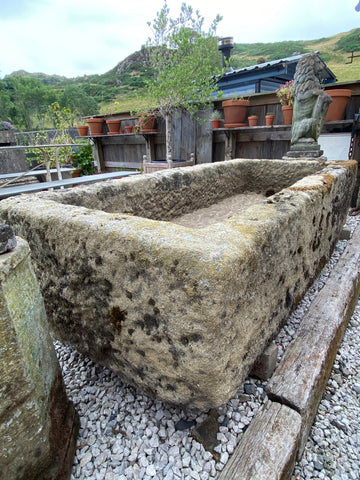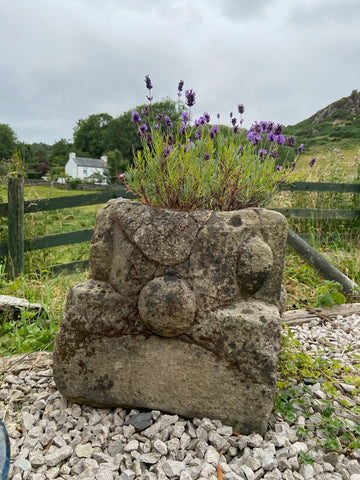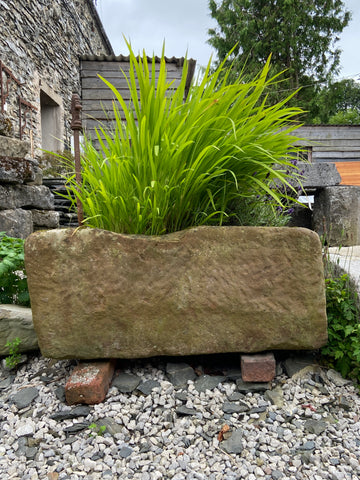There's more to stone troughs than just water
The need to store water, has been a problem faced by humanity ever since we hung up our hunting sandals, planted crops, began domesticating livestock, and started brewing beer. And the only abundantly available medium which had any real longevity, was stone and certainly until the introduction of casting (lead and iron) humankind had little option but to find large chunks of rock and slowly chip them into suitable containers.
As you might expect stone troughs were fairly ubiquitous across Cumbria and the Lake District, many were located alongside roads, there are still a few visible examples, including St Patrick’s Well, Glenridding, Station Yard Grange, Finkle Street, Sedbergh, and Ambleside Road, Windermere. Others were generally found close to field barns or lodged in walls between fields so that cattle or sheep could drink.

The stone used and the size of each trough can vary enormously, and in the main the size is determined by the local vernacular and whatever stone was most readily available. It is fairly usual to find small but very heavy limestone troughs in the Cartmel Valley, where the rock choices are generally sedimentary types, including sandstone, sedimentary slates, or mudstones, which can’t be carved (though troughs made from slate flags, bolted together do exist) or carboniferous limestone, which was in plentiful supply, happily, ideal trough material despite it being hard and as a result time consuming to hollow out.
As you might expect Yew Tree Barn holds a good stock of antique stone troughs, with a particular preference for the larger end of the scale. We recently sold a 12ft drinking trough (see pic). Dating the age of a trough is rather tricky, we once owned a trough that was purported to be Roman in origin, it was about the size of a small hot tub, and there’s no doubt it would have made a great plunge pool.
We also from time to time carry a selection of ‘Creeing’ troughs too, which are more unusual and quite often only found in the north, there are some particularly lovely medieval examples at Hexham Abbey. More often than not they were located by farm doors or in the kitchens of large houses. Their original purpose was as a receptacle in which to pound corn, barley or wheat until the husks fell off – in effect a giant pestle and mortar. The hulled wheat was then collected and boiled up to make frumenty, a form of porridge, typically with additional ingredients such as milk, egg yolks, and spices.

On occasions examples were repurposed as ‘plague stones’, there’s a particularly interesting example at Greengarth, Penrith. Others can still be seen on village and town boundaries, at the time of the Black Death they were often filled with vinegar, so that traders could disinfect coins used during business transactions between communities. It was believed the vinegar would act as a strong disinfectant and prevented the transfer of the contagion, needless to say it didn’t work.
Sadly, troughs are rarely dated. There are some notable exceptions to the rule, and these tend to be of the Civic variety. Many will date from the 19th century, and in some rare cases you’ll find a carved trough commemorating some historic local dignitary or some past good work or other. The reality is that dating anything older becomes seriously tricky, especially without some tacit provenance. After all stone troughs were often repurposed, so even though a trough might have a date inscribed that doesn’t necessarily mean that it can be accurately dated, because inevitably it will be much older and there’s just no way of knowing beyond that.
As previously mentioned, troughs performed a utilitarian function, long, large troughs were often for horses and cattle, and low shallow troughs for shorter legged animals, such as sheep and pigs. Today, however, troughs have a whole variety of uses, they make fantastic water features, after all the were designed to contain water, you could use a trough to create a simple pond, incorporate them into a cascade water feature or create a water sculpture with several troughs and the innovative use of other materials.

They also work very well as planters; shallow sinks are ideal for planting alpines and succulents and deeper troughs work well with an entire range of plants and flowers. Though you do need remember that you should do your homework and research which plants to use, as you will need to think about drainage.

You could even use your trough as a raised easy-care container in which to grow vegetables or as the ideal receptacle in which to establish an annual herb garden, with rosemary, chives, mint, and the like. It you wanted to really push the boat out you could even incorporate a stone trough or two into your interior design scheme, they make amazing bathroom sinks, plunge pools or even bathtubs depending on the size!
Whatever you decide to use a trough for; we carry a good stock covering all shapes and sizes, with something to suit every budget. To view our current stock visit: https://yewtreebarn.co.uk/collections/architectural

Leave a comment